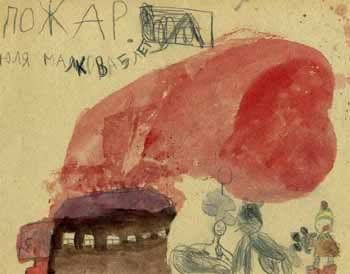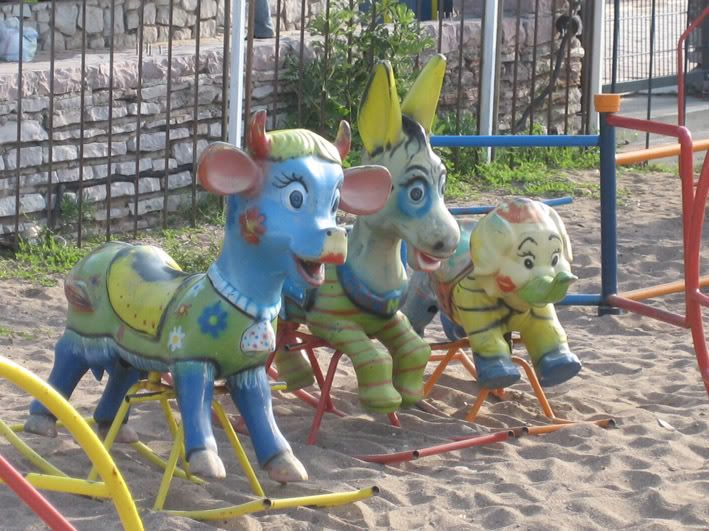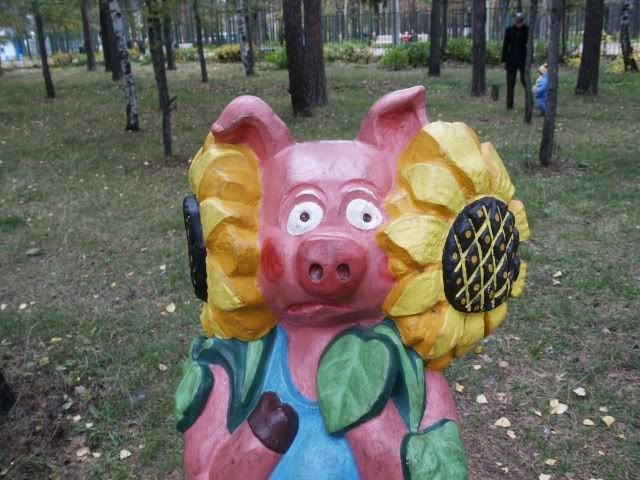This is a classic Damn Interesting article which originally appeared on 20 June 2006.The drill-rig enclosure, over 200 feet tallThe drill-rig enclosure, over 200 feet tallOver forty years ago, researchers in the Soviet Union began an ambitious drilling project whose goal was to penetrate the Earth's upper crust and sample the warm, mysterious area where the crust and mantle intermingle– the Mohorovičić discontinuity, or "Moho." So deep is this area that the Russian scientists had to invent new ways of drilling, and some of their new methods proved quite inventive. But despite the valiant effort which spanned several decades, the Russians never reached their goal, and many of the Earth's secrets were left undiscovered. The work done by the Soviets did, however, provide a plethora of information about what lies just beneath the surface, and it continues to be scientifically useful today. The project is known as the Kola Superdeep Borehole.Beginning in 1962, the drilling effort was led by the USSR's Interdepartmental Scientific Council for the Study of the Earth's Interior and Superdeep Drilling, which spent years preparing for the historic project. It was started in parallel to the Space Race, a period of intense competition between the U.S. and U.S.S.R. The survey to find a suitable drill site was completed in 1965 when project leaders decided to drill on the Kola Peninsula in the north-west portion of the Soviet Union. After five more years of construction and preparations, the drill began to nudge its way into the ground in 1970.Inside the project's 200-foot-tall enclosure resides a unique drilling apparatus. Most deep-drilling rigs use a rotating shaft to bore through the ground– using a series of extensions which are incrementally added as the hole grows deeper– but such a method was unworkable with a hole as deep as Kola was planned to be. To overcome this, the Russian researchers devised a solution where only the drill bit at the end of the shaft was rotated. They accomplished this by forcing the pressurized "drilling mud"– the lubricant pumped down the drill shaft– through the specially-designed drill bit to cause it to spin.Today, the deepest hole ever created by humankind lies beneath the tower enclosing Kola's drill. A number of boreholes split from the central branch, but the deepest is designated "SG-3," a hole about nine inches wide which snakes over 12.262 kilometers (7.5 miles) into the Earth's crust. The drill spent twenty-four years chewing its way to that depth, until its progress was finally halted in 1994, about 2.7 kilometers (1.7 miles) short of its 15,000-meter goal.Core samples from 6 km below the surface Core samples from 6 km below the surface The Soviet's drilling rig was designed such that core samples would be provided along the entire length of the drill shaft, providing researchers on the surface with an intimate look at the composition of the Earth as the drill ventured further downward. Before the superdeep borehole project was undertaken, practitioners of Geology had reached a number of conclusions regarding the Earth's deep crust based on observations and seismic data. But as is often the case when humans venture into the unknown, Kola illustrated that certainty from a distance is no certainty at all, and a few scientific theories were left in ruin. One scientist was heard to comment, "Every time we drill a hole we find the unexpected. That's exciting, but disturbing."To the surprise of the researchers, they did not find the expected transition from granite to basalt at 3-6 kilometers beneath the surface. Data had long shown that seismic waves travel significantly faster below that depth, and geologists had believed that this was due to a "basement" of basalt. Instead, the difference was discovered to be a change in the rock brought on my intense heat pressure, or metamorphic rock. Even more surprisingly, this deep rock was found to be saturated in water which filled the cracks. Because free water should not be found at those depths, scientists theorize that the water is comprised of hydrogen and oxygen atoms which were squeezed out of the surrounding rocks due to the incredible pressure. The water was then prevented from rising to the surface because of the layer of impermeable rocks above it.Another unexpected find was a menagerie of microscopic fossils as deep as 6.7 kilometers below the surface. Twenty-four distinct species of plankton microfossils were found, and they were discovered to have carbon and nitrogen coverings rather than the typical limestone or silica. Despite the harsh environment of heat and pressure, the microscopic remains were remarkably intact.The Russian researchers were also surprised at how quickly the temperatures rose as the borehole deepened, which is the factor that ultimately halted the project's progress. Despite the scientists' efforts to combat the heat by refrigerating the drilling mud before pumping it down, at twelve kilometers the drill began to approach its maximum heat tolerance. At that depth researchers had estimated that they would encounter rocks at 100°C (212°F), but the actual temperature was about 180°C (356°F)– much higher than anticipated. At that level of heat and pressure, the rocks began to act more like a plastic than a solid, and the hole had a tendency to flow closed whenever the drill bit was pulled out for replacement. Forward progress became impossible without some technological breakthroughs and major renovations of the equipment on hand, so drilling stopped on the SG-3 branch. If the hole had reached the initial goal of 15,000 meters, temperatures would have reached a projected 300°C (572°F).When drilling stopped in 1994, the hole was over seven miles deep (12,262 meters), making it by far the deepest hole ever drilled by humankind. The last of the cores to be plucked from from the borehole were dated to be about 2.7 billion years old, or roughly 32 million times older than Abe Vigoda. But even at that depth, the Kola project only penetrated into a fraction of the Earth's continental crust, which ranges from twenty to eighty kilometers thick.The Kola Core repository in ZapolyarniyThe Kola Core repository in ZapolyarniyKola was not the first nor the last attempt at drilling a superdeep borehole, but it has been the most successful so far. In 1957 the United States embarked on a similar project dubbed Project Mohole, but that attempt to drill through the ocean floor was cancelled due to lack of funding. Today, the Integrated Ocean Drilling Program seeks to penetrate the much thinner crust of the ocean floor to probe the Earth's lower crust.The Kola Superdeep Borehole is still a scientifically useful site, and research there is ongoing. The huge repository of core samples are housed at Zapolyarniy, about 10 kilometers south of the borehole. Today the site is managed by the State Scientific Enterprise on Superdeep Drilling and Complex Investigations in the Earth's Interior as the Deep Geolaboratory.
read more | digg story
Sunday, July 15, 2007
Gorbachev says Russia wants arms talks
FORMER Soviet leader Mikhail Gorbachev has said that Russia's decision to freeze a key European arms control treaty was taken in order to spark dialogue. "The decision of the head of state was an urgent call... to constructive dialogue and the implementation of the treaty,'' Mr Gorbachev was quoted as saying.
read more | digg story
read more | digg story
Monday, February 19, 2007
Soviet arcade game
Yeah! Today you have a chance to play in cult arcade game of the Soviet years. In the USSR it there was actually unique electronic game for children. Each child dreamed of it, asked parents to buy. And everywhere it was possible to hear these unforgettable peeping sounds. This game called "Nu Pogodi!"
So here it is: SOVIET ARCADE GAME (SWF release)
So here it is: SOVIET ARCADE GAME (SWF release)
Sunday, February 18, 2007
Children's paintings in russian schools
Well, having familiarized with these photos, you have already understood, that the childhood in the USSR and Russia is very heavy.
That you could be convinced finally of this, I represent you a collection of the children's figures made at schools of the former USSR.
OK, let's go!
Soldiers... (Somebody said, that author is Vladimir Putin, 5 years old)

Three pigs

Walking in the forest

The airplane

Rabbits...

The roof is on fire...

The small Cindirella

"Without drugs"

Sparrow

And, at last, The Electric Bunny

That you could be convinced finally of this, I represent you a collection of the children's figures made at schools of the former USSR.
OK, let's go!
Soldiers... (Somebody said, that author is Vladimir Putin, 5 years old)

Three pigs

Walking in the forest

The airplane

Rabbits...

The roof is on fire...

The small Cindirella

"Without drugs"

Sparrow

And, at last, The Electric Bunny

Thursday, February 15, 2007
Children's playgrounds in Russia
As is known, to understand the person, it is necessary to learn about his childhood. And that it is better to understand the nation, it is necessary to look what conditions children grow in.
Photos of several typical children's playgrounds in Moscow and other cities of Russia are shown here.
Let's go! ;)
N1 Surprisingly beautiful elephant with a delightful trunk

N2 Remarkable pig. It is pleasant to play with it in the silent summer evenings

N3 Three beautiful animals

N4 Nice robot

N5 This is the character of a children's fairy tale. His name is Cheburashka.

N6 Nice pig again

N7 And again...

N8 And it is the malicious and terrible tiger!

N9 At last, the monument to the whole Soviet age

I hope, you began to understand is better people from Russia and from the former USSR!
To be continued...
Photos of several typical children's playgrounds in Moscow and other cities of Russia are shown here.
Let's go! ;)
N1 Surprisingly beautiful elephant with a delightful trunk

N2 Remarkable pig. It is pleasant to play with it in the silent summer evenings

N3 Three beautiful animals

N4 Nice robot

N5 This is the character of a children's fairy tale. His name is Cheburashka.

N6 Nice pig again

N7 And again...

N8 And it is the malicious and terrible tiger!

N9 At last, the monument to the whole Soviet age

I hope, you began to understand is better people from Russia and from the former USSR!
To be continued...
Subscribe to:
Comments (Atom)
